Despite winning Serie B with a fantastic campaign in 2021/22, US Lecce’s future in Serie A was understandably questioned in the summer.
Throughout their history, the Apulia-based club constantly yo-yoed up and down Italy’s football pyramid.
If history was anything to go by, the Giallorossi’s survival chances were low coming into this season.
However, with 59-year-old Marco Baroni in charge, the situation is different.
Baroni played professionally in the 80s and 90s — Serie A’s golden era.
Despite the efforts of
Arrigo Sacchi and Zdeněk Zeman, Italy’s tactical identity was primarily viewed as defensive.
The ultimate objective was winning, regardless of whether the football was attractive or not.
Baroni’s time at Lecce has clearly resembled that philosophy.
In last year’s Serie B, the Giallorossi
conceded only 31 goals, the fewest ofany team in the competition.
Upon arriving in the first division, Baroni chose to continue this approach.
While Monza, for instance, looked to bolster their offensive options, Lecce went the opposite route.
For instance, Barcelona’s Samuel Umtiti, former Borussia Dortmund Marin Pongračić, and Federico Baschirotto were some of the more notable additions — all centre-backs.
The squad was improved around Marco Baroni’s coaching style.
So far, this system has proven extremely successful.
Lecce have the sixth-best defence in the league and the fifth-best xGA.
This defensive security has allowed them to go head-to-head with Italy’s giants, recently defeating Atalanta and Lazio.
In this tactical analysis, we will explore Lecce’s tight defensive system under Marco Baroni’s tactics and examine how the Giallorossi have avoided relegation halfway through the season.
This analysis will specifically focus on the defensive side of Baroni’s tactics, although we will also briefly go over their attacking performances.
Lecce Data overview
Before examining the details of Lecce’s defence, we can use data to convey a good sense of their performance and style.
Overall, at the time of writing, Lecce have conceded 20 goals from 20.53 xGA.
This figure is extremely promising, especially considering that Lecce was only recently promoted compared to the rest of Serie A.
However, there is an unbelievable contrast on the attacking side of things.
At 42.3%, Baroni’s side averages the lowest possession figure in the entire league.
Similarly, their 18 goals so far are the seventh-worst in the league, and their 16.71 xG is the lowest in the league.
It is more than fair to say Lecce is a defensive side, and if they wish to escape the relegation battle sooner rather than later, they must improve their possession work.
Nonetheless, their security at the back deserves credit.
This starts with a relatively passive approach.
Unsurprisingly, their PPDA of 11.92 is the fifth-highest in Serie A.
That is not to say that Baroni’s men sit deep the entire time.
Under the right circumstances, they will advance from their mid-block and look to press the opponent high.
Nonetheless, their initial structure begins in a traditional mid-block, as seen in their defensive territory map below.
In addition to the height of their block, the map also identifies their strategy without the ball — force the opponent wide.
The majority of their defensive actions in the middle and final third occur in the wide areas.
Lecce Defensive Territory Map
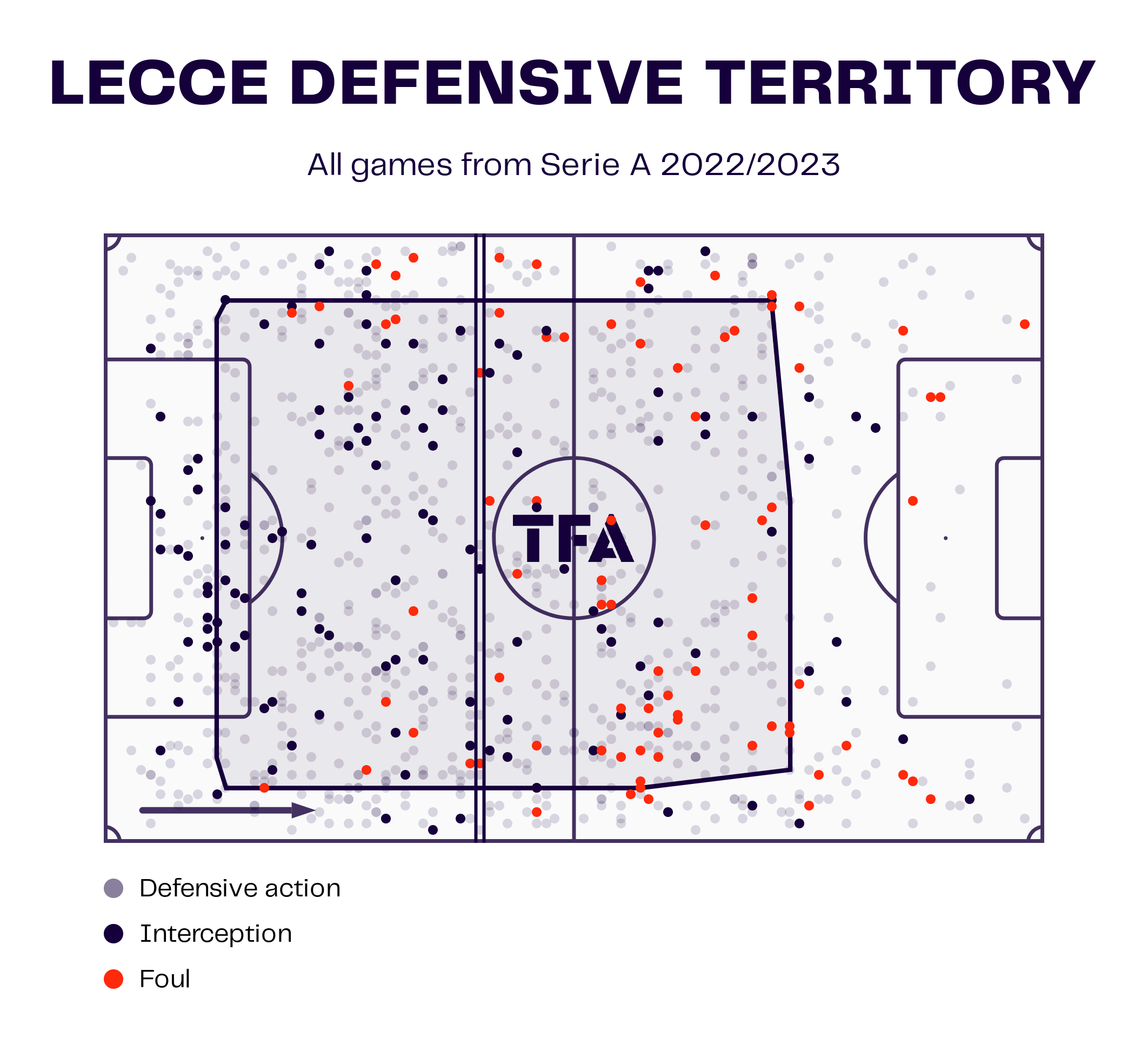
Although Lecce tends to concede possession to the opposition quite significantly, they are still able to keep the opponent away from their goal.
Their 10.47 shots against per 90 are lower than the league average — an impressive feat considering they average such little possession.
Of these shots against, the average xG per shot is only 0.1, which is the third-lowest in the league.
Naturally, their defensive duels and interception metrics are quite high.
However, this defensive approach is more by choice rather than necessity.
For instance, Hellas Verona, Cremonese, and Empoli all average similarly low possession figures, but none of them boast the same level of security as Lecce.
This is a conscious and extremely well-executed defensive plan from their leader, Marco Baroni.
Central overload
Data aside, it is time to examine how they have been so successful defensively.
The data obviously indicates extreme security, and it is because of Giallorossi’s balanced system.
This system is usually carried out in a 4-1-4-1/4-5-1 hybrid.
Both formations can be seen or at least turned into very defensive structures.
That is especially the case with Baroni’s side.
They usually begin in a very compact mid-block, without much space between the first and last defensive line.
The wingers have very defensive roles, and they are instructed to track back to compose the midfield line.
The two midfielders, which flank the central defensive midfielder, have opposing roles.
These roles are key to the functioning of the whole system.
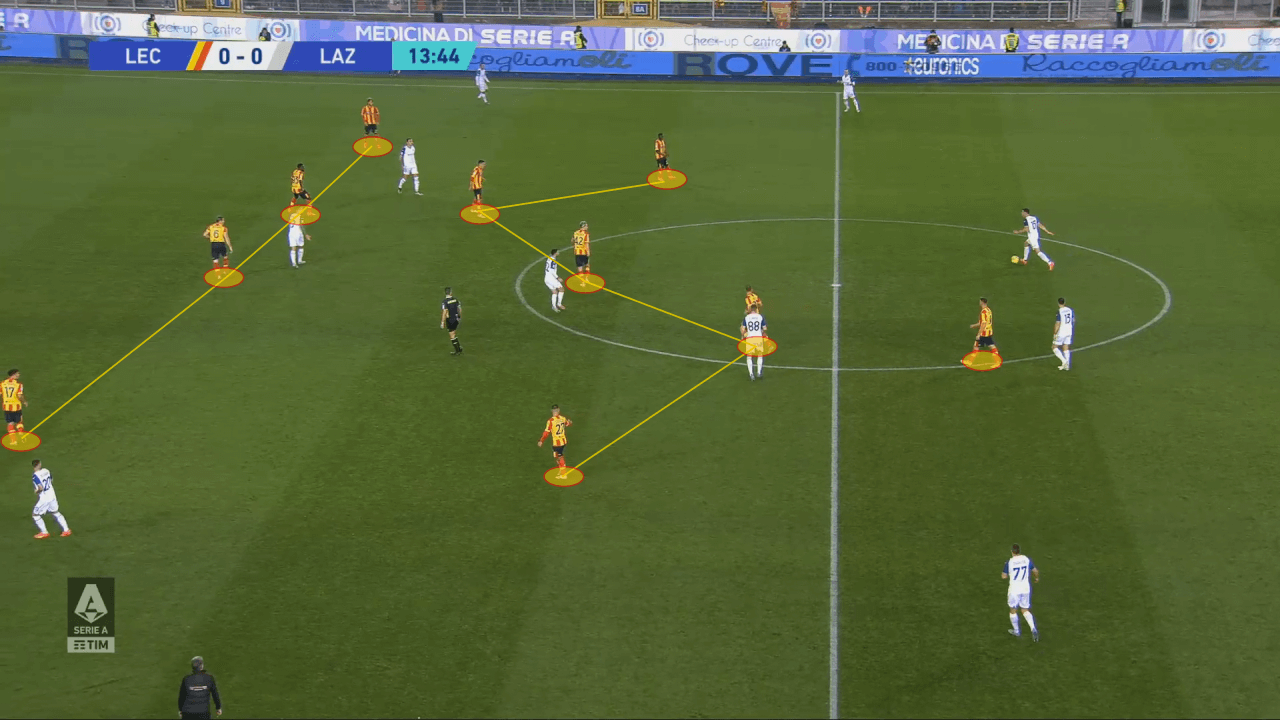
Normally, the lone centre-forward, usually Milan’s on-loan Lorenzo Colombo, will apply pressure on the centre-backs as they look for options.
However, Colombo tends to mostly focus on the left centre-back.
This is because Lecce’s 20-year-old left central midfielder, Joan González, is extremely good at bursting forward and pressing the opposition’s right centre-back, as seen below.
This coordinated movement allows Lecce to maintain some pressure on the centre-backs and prevent them from having too much time to create.
This is especially effective against top sides, whose centre-backs are extremely good at picking out dangerous passes.
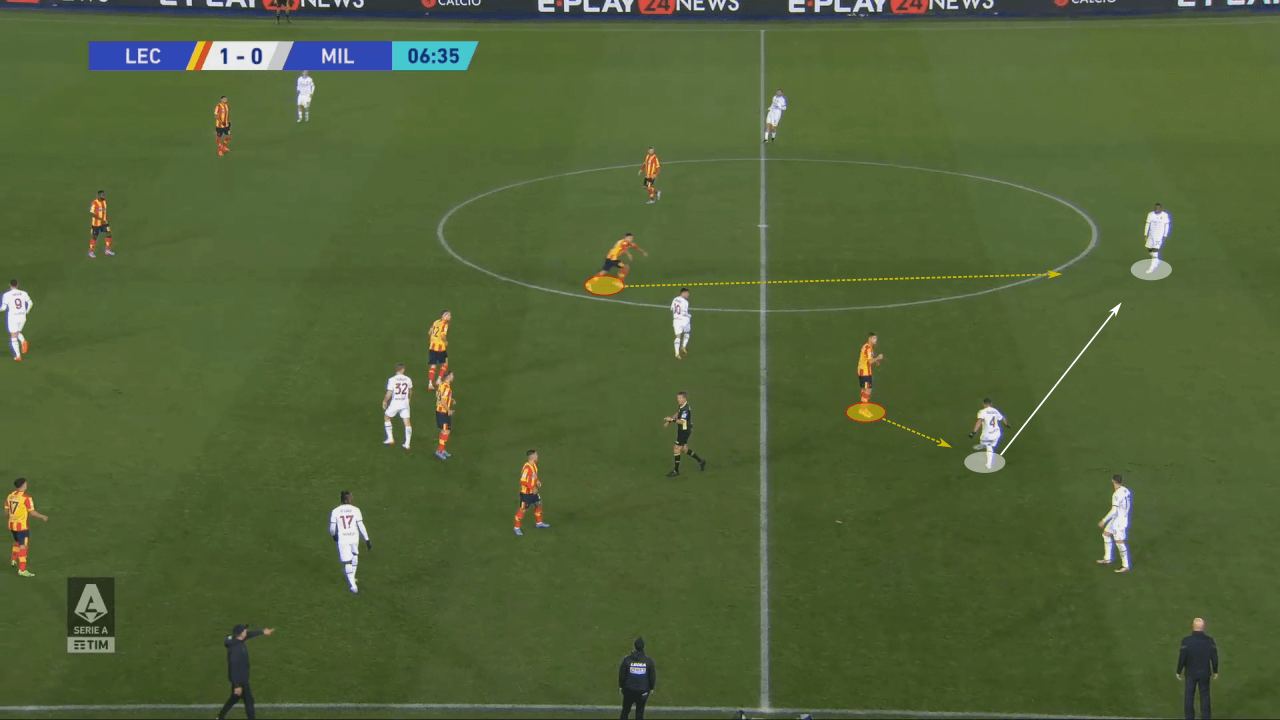
In another instance, we can see this behaviour more clearly.
As Milan begins to play backwards, Lecce advances the height of their block and looks to pressure the opponent.
Colombo then stays between the defensive midfielder and the right centre-back while González jumps to Milan’s left centre-back.
To cover for this, Umtiti steps up from his centre-back position to pick up Milan’s midfielder.
This is rather aggressive and could even be seen as risky.
At any rate, Lecce picks these moments to step up very carefully and rarely leaves themselves exposed.
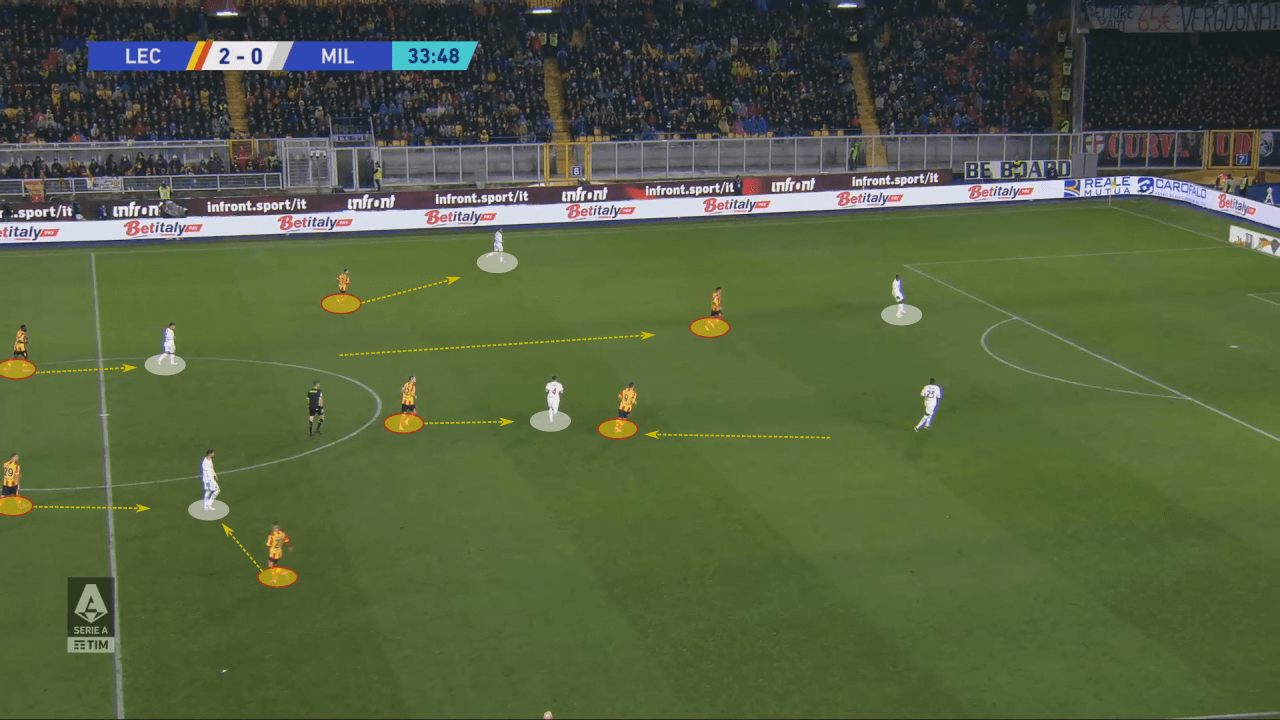
This aggressive movement from the centre-backs can be seen in other instances.
Again, Lecce are very successful in picking out exactly when to step up and overwhelm the opponent.
In this example against Atalanta, Baschirotto steps up rather aggressively to create a 4v2 around the ball and keep the opponent from progressing.
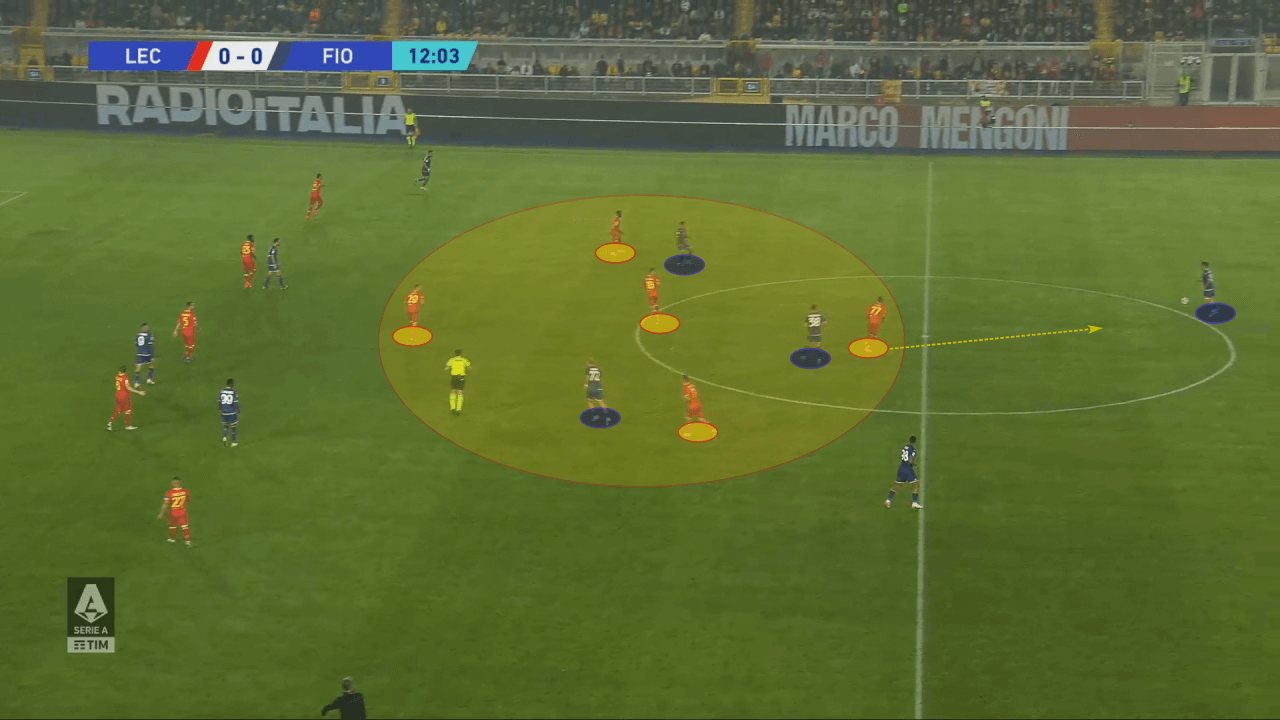
Baroni’s mid-block does a great job of offering this balance.
They can step up their structure and press their opponents more aggressively at times.
However, it also allows them to remain compact and limit the opponent’s options.
In the instance below, the centre-forward steps up to press the centre-backs.
With the nearest winger remaining narrow, they can create a 4v3 (excluding the centre-forward) against Fiorentina’s midfield and keep them from effectively progressing the ball.
This midfield pack does a fantastic job of moving as a unit and creating superiority where needed.

Lecce Defending deep
With such a compact midfield structure, Lecce consequently tend to force the opposition to the wide areas.
First, by doing this, Baroni’s men ensure the opposition does not create chances through the central lanes, where the most dangerous chances tend to come from.
In the wide areas, they also defend extremely well.
In this specific instance against Fiorentina, we can see this general system more clearly.
The 4-5-1 is extremely compact, with the wingers and the fullbacks coming inside.
This forces the midfield to create through the wide areas.
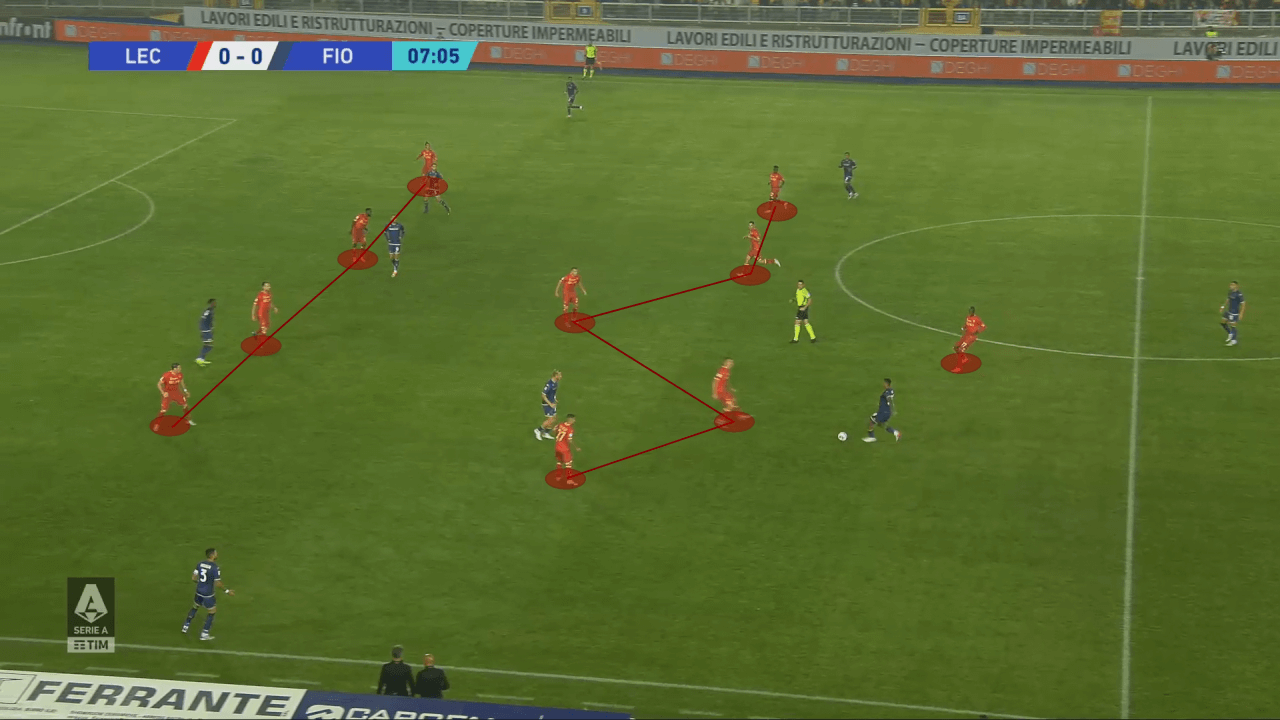
In the wide channels, through collective disciplined movement, they are able to shift their block across and maintain superiority.
A few seconds after the last instance, Fiorentina attempted to play through their left wing.
Lecce’s nearest midfielder shifts wide and joins the right-back and right-winger to create a 3v2.
The right centre-back also comes along to track their forward, and the defensive midfielder stands just inside, providing cover.
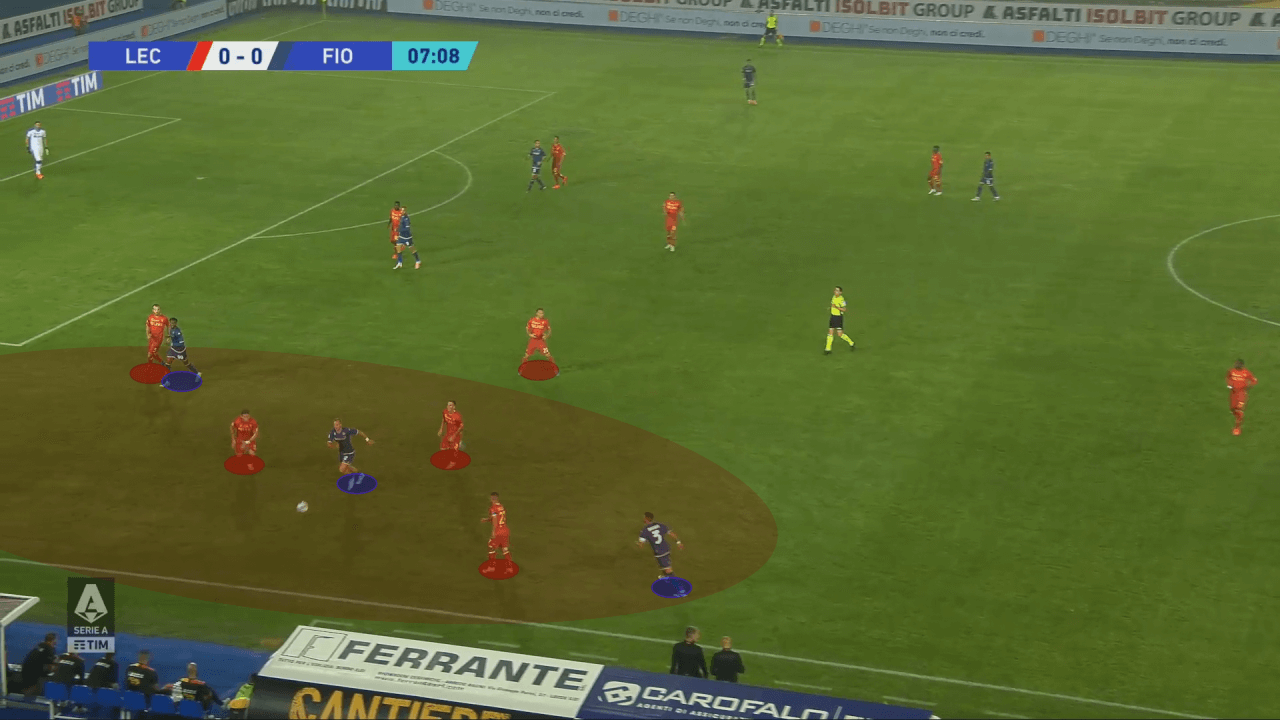
On the opposite flank, now against Lazio, we see a similar situation.
Lazio have progressed into Lecce’s third, but the Giallorossi still have superiority and keep the opposition from creating anything.
With their compact block, they create a 5v2 on the left side and ensure safety.
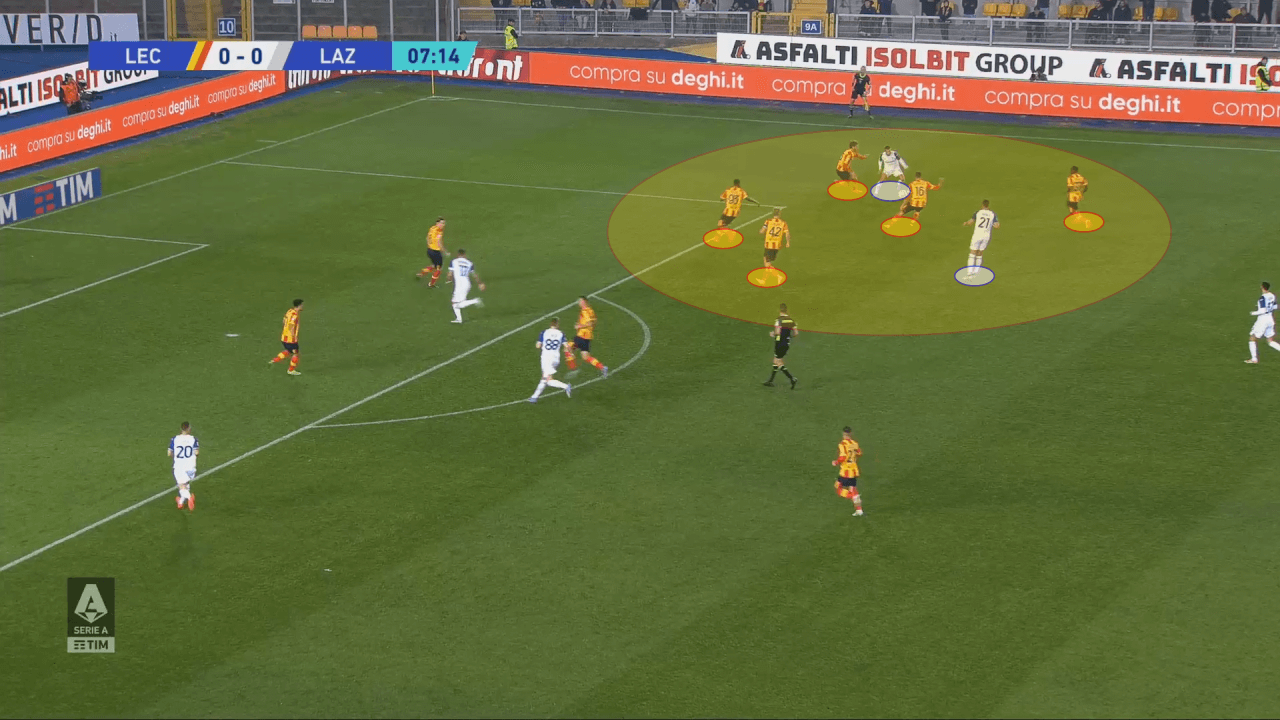
If the opponent does manage to get a cross in, Lecce are extremely comfortable defending balls into the box.
Since their block constantly remains compact, as they begin to drop deep, they can have a lot of numbers in their own box to defend.
Obviously, they must still do a good job of picking players up and keeping anyone from going up by themselves.
Nonetheless, in this setup, they are well-equipped to defend attempts to put the ball in the box.
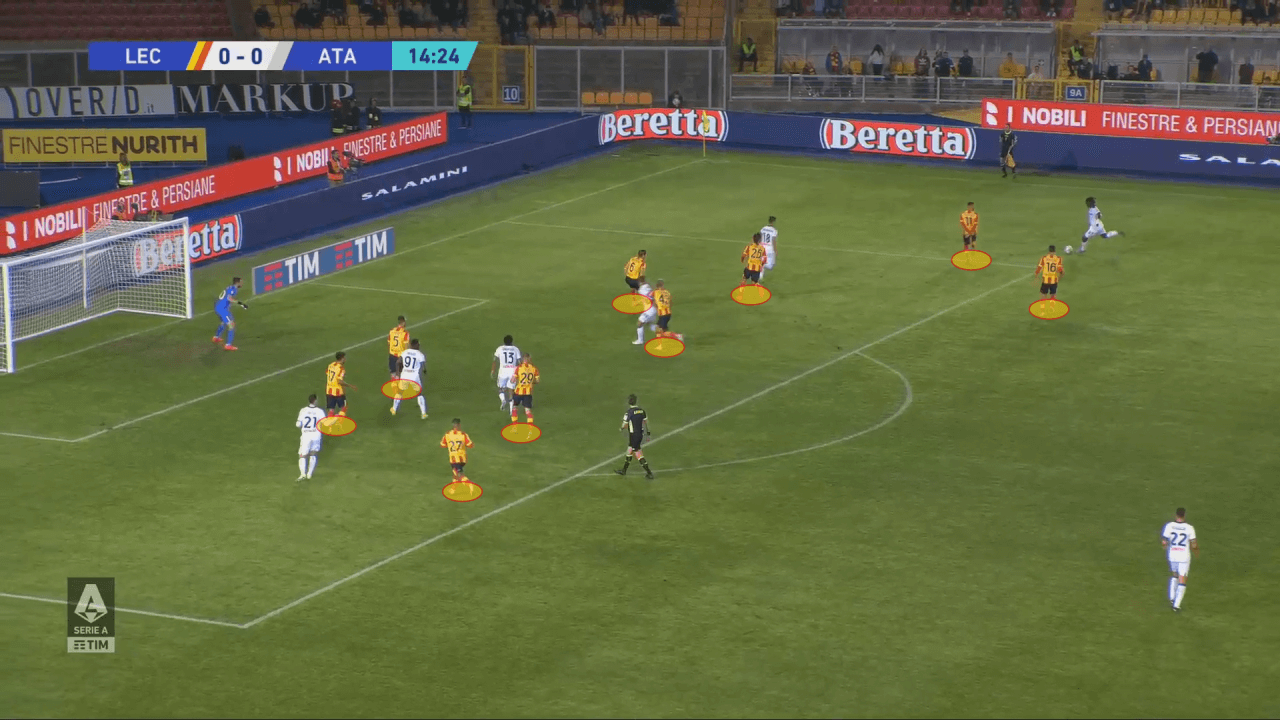
Conclusion
In 2022/23, Lecce have been an extremely defensive side under Marco Baroni’s tactics.
In the summer, the Giallorossi invested in Baroni’s approach and significantly upgraded the quality of the squad.
It has certainly proven successful on both ends. Heading into the second half of the season, Lecce has one of the best defences in the entire league.
Their initial mid-block provides great balance, both laterally and vertically.
They can quickly advance their press and step up to a high block or sit tight and keep the opponent from progressing.
Their structure provides an initial overload in the central channels, forcing the opponent to create through the wide channels.
In these areas, they are extremely good at shifting across and keeping the opposition from coming inside.
If they resort to deep crosses, Lecce can also get numbers in its own box and defend.
Marco Baroni has assembled a complete and highly successful defensive system, and it has rewarded them with a safe position in the league.
It will be interesting to see if they keep up this security — their current data certainly indicates as much!





Comments